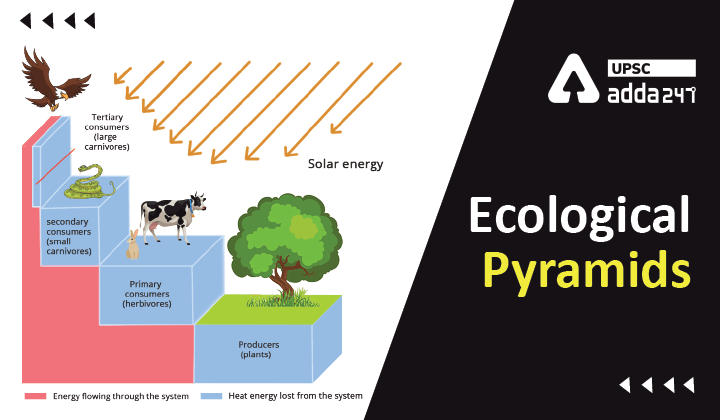Table of Contents
Ecological Pyramid UPSC
What is ecological pyramid?
- Ecological pyramids are a graphical representation to illustrate the relationship between different living organisms, based on their ecological position.
- The ecological pyramid consists of a number of horizontal bars depicting specific trophic levels.
- It came into existence due to famous scientist such as Charles Elton, G. Evelyn Hutchinson, and Raymond Lindeman.
- It has numerous names like Eltonian pyramid after Charles Elton, energy pyramid, trophic pyramid, and food pyramid.
Ecological pyramid types
There are three types of ecological pyramids.
- Pyramid of numbers
- Pyramid of biomass
- Pyramid of energy
Pyramid of numbers
- Pyramid of numbers represent the total numbers of individuals of different species present in each trophic level.
- The term “pyramid of numbers” was coined by Charles Elton in 1972.
- The pyramid of numbers can be both upright and inverted, depending upon the size.
- One of the major drawbacks of pyramid of numbers is that it is very difficult to count the number of all the organisms.
- Due to this reason, the pyramid of number does not represent the true picture of trophic structure of ecosystem.
Upright pyramid of numbers
- In this type of pyramid, the number of individuals decreases from lower level to higher trophic level.
- Examples: Grassland ecosystem and pond ecosystem
- Trophic structure: Grass—grasshopper—rats—snakes—hawk.
Inverted pyramid of numbers
- In this type of pyramid, the number of individuals is increased from lower level to higher trophic level.
- Example: Tree ecosystem.
Pyramid of biomass
- Pyramid of biomass indicates the total mass of organisms in a particular trophic level.
- Biomass is the amount per unit area product of the living material existing in an individual or a number of individuals at in particular trophic level.
- Biomass at a certain trophic level is calculated by multiplying the number of individuals within the trophic level with the average mass of an individual in a particular area.
- This pyramid overcomes the size difference problem in pyramid of numbers because all kinds of organisms at a trophic level are weighed.
- Each trophic level has a certain mass of living material at a particular period called the standing crop.
- Biomass always reduces with an increase in trophic level, and approximately 10% to 20% of the biomass is passed from one trophic level to the other.
Upright pyramid of biomass
- Upright pyramid of biomass has a large base mainly consisting of primary consumers, the smaller trophic levels are located at the top.
- The biomass of producers (autotrophs) is the maximum. So, they are kept at the bottom. The biomass of next trophic level i.e., primary consumers is less than the producers. So, they are kept above autotrophs. The biomass of next higher trophic level i.e., secondary consumers is less than the primary consumers. The top, high trophic level has very less amount of biomass. So, they are kept at the top.
- Example: Terrestrial ecosystem.
Inverted pyramid of biomass
- In inverted pyramid of biomass, the pyramid has a small base, with the consumer biomass exceeding the producer biomass and the pyramid assumes an inverted shape.
- Example: aquatic ecosystem.
- It is because the producers are tiny phytoplankton that grows and reproduces rapidly.
Pyramid of energy
- Energy pyramid is most suitable to compare the functional roles of the trophic levels of an ecosystem.
- An energy pyramid represents the amount of energy at each trophic level and loss of energy from one trophic level to next trophic level.
- Pyramid of energy is always upright pyramid as it illustrates the flow of energy from producers to consumers.
- Pyramid of energy indicates the actual role played by various organisms in energy transfer.
- The pattern of energy flow can be described based on the law of thermodynamics which states that energy is neither created nor destroyed it is only transformed from one form into another.
Read UPSC favourite topics





 TSPSC Group 1 Question Paper 2024, Downl...
TSPSC Group 1 Question Paper 2024, Downl...
 TSPSC Group 1 Answer key 2024 Out, Downl...
TSPSC Group 1 Answer key 2024 Out, Downl...
 UPSC Prelims 2024 Question Paper, Downlo...
UPSC Prelims 2024 Question Paper, Downlo...
